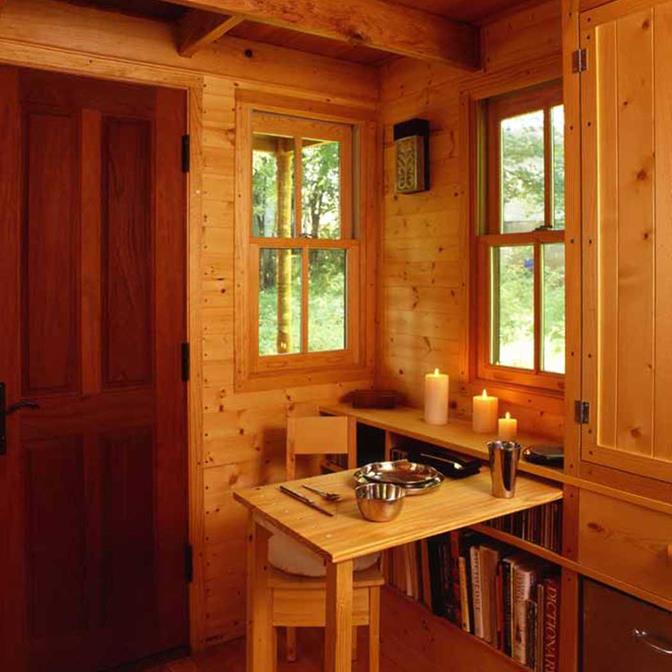Utilities
Like the rest of the house, utilities and appliances were designed with simplicity and sustainability in mind. They met my modest needs but would be considered primitive by conventional American standards. These rudimentary utilities certainly would not appeal to everyone interested in living in a small home, and it should be made clear that living small does not require deprivation. Hot and cold running water, a microwave oven, and cable TV are all available options.
Water: Tumbleweed was supplied by a simple, gravity-fed plumbing system. A two-and-a-half-gallon pot sat on a metal shelf just above a horizontal section of stovepipe in the overhead kitchen cabinet and drained into either the kitchen sink or shower through a Y intersection in a short stretch of rubber hose. The water was kept warm as long as the heat stove was on, and it could be made hot by setting the pot directly on the stove or a burner. The pot was filled at a nearby spigot. Gray water drained directly into the garden.
Heating and Cooking: The best source of heat most structures can use is that of the sun. I installed windows on all but what was intended as the north wall of Tumbleweed for good solar gain. A covered porch on the south side kept the heat of the high summer sun out while letting the lower winter rays flood the house with their warmth. A gas heater kicked in on cloudy days and cold nights. I chose a gas stove over a wood one mostly because gas stoves only require about one-sixth as much clearance from flammable surfaces. This, in turn, allowed me to have pine walls without having to put my heater right in the middle of an already tiny room. The cleanliness of gas also seemed to make sense in a small space, and I liked the idea of precise control with a thermostat rather than the frequent stoking that a small wood stove requires.
The propane tank that fed the heater also supplied an R. V. cooktop. It is upon this same double burner that a camp oven was set for baking.
Toilet: My composting toilet amounted to little more than an airtight bucket, a can of sawdust and a couple of compost piles outside. Sordid story short, the bucket was used as an indoor toilet and sawdust was put into the mix to absorb odor and balance out the carbon-to-nitrogen ratio. This bucket was emptied onto one compost pile or the other every so often, then rinsed. (Please see J. C. Jenkins, The Humanure Handbook, for details on this and other methods of composting human manure.) While the idea of carrying one’s own poop (or anybody else’s for that matter) to a compost pile off away from central living quarters may sound both inconvenient and plainly unacceptable to most Westerners, its appeal for more than a few will be its absolute efficiency. Without electricity, running water, or waste and only small inconvenience as its price, a cleaner environment and soil-building compost are made available.
Electricity: By now, these description of rudimentary plumbing and a plastic chamber pot may have made it sound as if my house was more derelict than homey. But, as I have said, these utilities were of my choice, and for me, choice is, in itself, a luxury. In fact, there was plenty of room for modern conveniences. The integral CD player, TV, and VCR disqualified the house as an ascetic’s shanty. These appliances, along with six lights, two fans, and a radio, were all powered by the sun through a single solar panel. I chose not to mount the panel on my roof but kept it separate. This allowed me to situate the house in a shady place during the summer while collecting energy at the same time.
|
|







Leave a reply